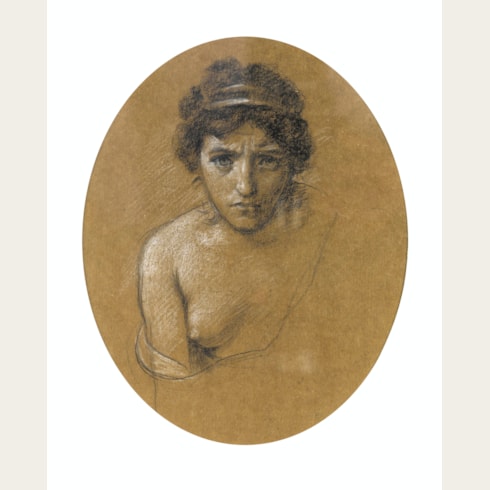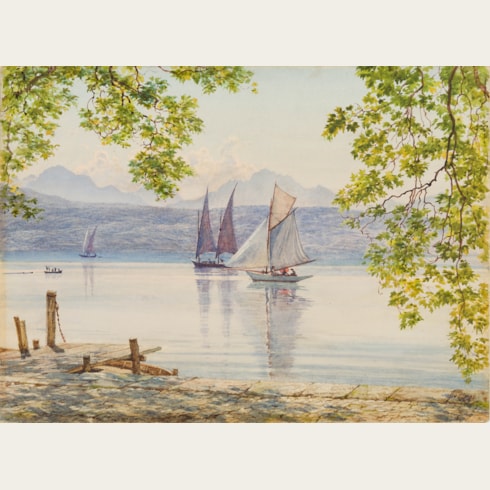Edward John POYNTER
(Paris 1836 - London 1919)
Lynmouth, Devon
Sold
Watercolour and gouache.
Signed with monogram, dated and titled 18 EJP 66 Lynmouth at the lower right.
305 x 464 mm. (12 x 18 1/4 in.)
ACQUIRED BY THE METROPOLITAN MUSEUM OF ART, NEW YORK.
Signed with monogram, dated and titled 18 EJP 66 Lynmouth at the lower right.
305 x 464 mm. (12 x 18 1/4 in.)
ACQUIRED BY THE METROPOLITAN MUSEUM OF ART, NEW YORK.
Though Poynter is not generally thought of as a watercolour draughtsman, it should not be forgotten that his father Ambrose was an amateur watercolour painter of some talent, and that his earliest artistic training was with the topographical watercolourist Thomas Shotter Boys. He was elected to the Royal Society of Painters in Water-Colour in 1883, and used the medium of watercolour mostly for landscapes – views in Italy, Scotland and elsewhere - and informal portraits. Most of Poynter’s few watercolour landscapes date from early in his career. These tend to be records of places he visited, and are among his most personal works, done for his own pleasure and seldom exhibited. (In later years, however, the artist consented to show some of his landscape watercolours at the Fine Art Society, the Grosvenor Gallery and the New Gallery.) In contrast to the more atmospheric effects and diffused forms of the work of many of his contemporaries, however, his watercolour technique remained precise and controlled, with a restrained colour scheme.
The present watercolour, drawn in 1886 when the artist was aged thirty, is a fine example of this. As one contemporary critic noted, ‘It is not too much to claim that, as Sir Edward Poynter’s more ambitious work is of [a] classic order, something of the same quality has overflowed into these small but choice water-colours which are his recreation (as he himself says), from the more severe duties of his positions as chief craftsman, instructor and governor of certain national institutions. His work is not aggressive at all; it does not even attempt sober tours de force; it is merely strong, and simple, and reposeful, and, as a rule, English. But somehow it has a way of making one want to see it again, and to pore over it – just as have his crayon studies...These water-colours are less known, but in their way they have that same reticent beauty which have those well-known figure drawings...There is a peculiar mental quality in them which is at once charming and dignified, despite its suspicion of severity.’
Another contemporary writer noted of Poynter’s watercolours that his ‘love of nature and profound knowledge of plant life enable him to see and feel a keener enjoyment in landscape art than the generality of artists, and his pictures are evidently the expression of his own sincere joy in the beauty of nature...a sound knowledge of draughtsmanship and a sense of refined and beautiful colour enable him to carry out his ideas very rapidly...Sir Edward is particularly happy in catching the true atmospheric tones, and a certain serenity of outlook and restrained colour ensure the sense of repose which is characteristic of his landscapes.’
The coastal village of Lynmouth in Devon, at the northern edge of Exmoor National Park, was once described by Thomas Gainsborough as ‘the most delightful place for a landscape painter that this country can boast.’ The surrounding coastline, noted for high sea cliffs, was popular with Victorian artists, including William Henry Millais, George Price Boyce and James Collinson. In this atmospheric watercolour, a small boat is seen in the midst of the sea, dwarfed by the coastal cliffs and a rainstorm that is sweeping across the composition. (In a review of the Grosvenor Gallery exhibition of 1877, Oscar Wilde singled out this watercolour in particular: ‘there is a good effect of Mr. Poynter’s, the east wind seen from a high cliff sweeping down on the sea like the black wings of some god.’) The suggestion of an approaching storm is tempered by the hint of better weather evident in the sunshine breaking through the clouds in the far distance.
Another Devonshire watercolour by Poynter of the same date as the present sheet is a view of The Castle Rock at Lynton, a village adjacent to Lynmouth, which was formerly in the Ingram collection and appeared at auction in 2005. This watercolour almost certainly belonged to the Conservative MP Alfred Baldwin (1841-1908), father of the future Prime Minister Stanley Baldwin. Through his wife, Louisa Macdonald, Alfred Baldwin was Poynter’s brother-in-law. The couple were married in August 1866, and the present sheet, which is dated that year, may indeed have been intended as a wedding present. Louisa Macdonald was the sister of both Agnes Poynter and Edward Burne-Jones’s wife, Georgiana, as well as Alice Kipling, the mother of Rudyard Kipling.
The present watercolour, drawn in 1886 when the artist was aged thirty, is a fine example of this. As one contemporary critic noted, ‘It is not too much to claim that, as Sir Edward Poynter’s more ambitious work is of [a] classic order, something of the same quality has overflowed into these small but choice water-colours which are his recreation (as he himself says), from the more severe duties of his positions as chief craftsman, instructor and governor of certain national institutions. His work is not aggressive at all; it does not even attempt sober tours de force; it is merely strong, and simple, and reposeful, and, as a rule, English. But somehow it has a way of making one want to see it again, and to pore over it – just as have his crayon studies...These water-colours are less known, but in their way they have that same reticent beauty which have those well-known figure drawings...There is a peculiar mental quality in them which is at once charming and dignified, despite its suspicion of severity.’
Another contemporary writer noted of Poynter’s watercolours that his ‘love of nature and profound knowledge of plant life enable him to see and feel a keener enjoyment in landscape art than the generality of artists, and his pictures are evidently the expression of his own sincere joy in the beauty of nature...a sound knowledge of draughtsmanship and a sense of refined and beautiful colour enable him to carry out his ideas very rapidly...Sir Edward is particularly happy in catching the true atmospheric tones, and a certain serenity of outlook and restrained colour ensure the sense of repose which is characteristic of his landscapes.’
The coastal village of Lynmouth in Devon, at the northern edge of Exmoor National Park, was once described by Thomas Gainsborough as ‘the most delightful place for a landscape painter that this country can boast.’ The surrounding coastline, noted for high sea cliffs, was popular with Victorian artists, including William Henry Millais, George Price Boyce and James Collinson. In this atmospheric watercolour, a small boat is seen in the midst of the sea, dwarfed by the coastal cliffs and a rainstorm that is sweeping across the composition. (In a review of the Grosvenor Gallery exhibition of 1877, Oscar Wilde singled out this watercolour in particular: ‘there is a good effect of Mr. Poynter’s, the east wind seen from a high cliff sweeping down on the sea like the black wings of some god.’) The suggestion of an approaching storm is tempered by the hint of better weather evident in the sunshine breaking through the clouds in the far distance.
Another Devonshire watercolour by Poynter of the same date as the present sheet is a view of The Castle Rock at Lynton, a village adjacent to Lynmouth, which was formerly in the Ingram collection and appeared at auction in 2005. This watercolour almost certainly belonged to the Conservative MP Alfred Baldwin (1841-1908), father of the future Prime Minister Stanley Baldwin. Through his wife, Louisa Macdonald, Alfred Baldwin was Poynter’s brother-in-law. The couple were married in August 1866, and the present sheet, which is dated that year, may indeed have been intended as a wedding present. Louisa Macdonald was the sister of both Agnes Poynter and Edward Burne-Jones’s wife, Georgiana, as well as Alice Kipling, the mother of Rudyard Kipling.
One of the leading artistic figures of Victorian England, Edward Poynter made his reputation as a painter of historical subjects, often set in ancient times, in which precise archeological detail, interesting narrative themes and a polished technique were combined with great effect. His first success came with the painting Israel in Egypt, exhibited at the Royal Academy in 1867, and his reputation continued to rise throughout his career, enhanced by such popular paintings as A Visit to Aesculapius, painted in 1880. His grandest production was the monumental The Visit of the Queen of Sheba to King Solomon, painted between 1883 and 1890 and today in the Art Gallery of New South Wales in Sydney, Australia. Among the public commissions he received were for the decoration of the interior of the Palace of Westminster and the Royal Albert Hall.
Poynter also worked in watercolour and fresco, and made designs for stained glass, mosaic and ceramics. Apart from being the first Slade Professor of Art at University College in London, Poynter was appointed Director of the National Gallery in 1894 (the last artist to hold the position) and, from 1896, served concurrently as President of the Royal Academy.
A versatile and gifted draughtsman and a firm advocate of life drawing, Poynter made numerous figure studies for each of his paintings. His drawings were greatly admired in his lifetime. As one recent scholar has noted, ‘By the late 1860’s Poynter’s graphic work was renowned for its excellence, and by the 1880s he was hailed by his contemporaries as the finest British figure draughtsman of his time.’ One contemporary writer, in a book devoted solely to the artist’s drawings, noted of Poynter’s preparatory studies for his paintings that ‘In the bold vigour of his generalizations, in the minute and searching attention to details, and in the broad and masterly use of the material, be it charcoal, chalk, or pencil, we perceive how conscientiously he has laid to heart the example long since set by Michel Angelo.’
Provenance
Probably Alfred Baldwin, M.P., Lower Park, Bewdley, Wilden House, Worcestershire and London
Chris Beetles, London, in March 2002
Christopher Cone, Whitby.
Literature
‘The Grosvenor Gallery’, The Times, 1 May 1877, p.10 (‘By Mr. Poynter, are in this room [East Gallery], a portrait of Mrs. Burne-Jones (37), and a landscape view from a window at Lynmouth (37A)’, and. in the Watercolour Room, ‘a study of sea rippled by west wind, by Poynter’): Oscar Wilde, ‘The Grosvenor Gallery’, The Dublin University Magazine, July 1877, p.126; Huon Mallalieu, ‘The virgin and the vamp’, Country Life, 5 August 2015, p.85, fig.7.
Exhibition
London, The Grosvenor Gallery, 1877; Probably London, The Fine Art Society, Exhibition of Water Colours and Studies by Sir E. J. Poynter, Bart., P.R.A., November 1903, no.125 (‘The West Wind, Lynmouth. (1865.) Lent by Mr. A. Baldwin, M.P.’) or no.165 (‘Lynmouth. (1865.) Lent by Mr. A. Baldwin, M.P.’).








